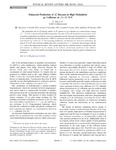Enhanced production of Λ°b baryons in high-multiplicity pp collisions at √s = 13 TeV

Use this link to cite
http://hdl.handle.net/2183/42117Collections
- Investigación (FCIE) [1260]
Metadata
Show full item recordTitle
Enhanced production of Λ°b baryons in high-multiplicity pp collisions at √s = 13 TeVDate
2024-02Citation
R. Aaij et al. (LHCb Collaboration). Enhanced production of Λ°b baryons in high-multiplicity pp collisions at √s = 13 TeV. Phys. Rev. Lett. 132, 081901 (2024). https://doi.org/10.1103/PhysRevLett.132.081901
Abstract
[Abstract] The production rate of Λ°b baryons relative to B° mesons in pp collisions at a center-of-mass energy √s = 13 TeV is measured by the LHCb experiment. The ratio of Λ°b to B° production cross-sections shows a significant dependence on both the transverse momentum and the measured charged-particle multiplicity. At low multiplicity, the ratio measured at LHCb is consistent with the value measured in e+ e− collisions and increases by a factor of ∼ 2 with increasing multiplicity. At relatively low transverse momentum, the ratio of Λ°b to B° cross-sections is higher than what is measured in e+ e− collisions, but converges with the e+ e− ratio as the momentum increases. These results imply that the evolution of heavy b quarks into final-state hadrons is influenced by the density of the hadronic environment produced in the collision. Comparisons with several models and implications for the mechanisms enforcing quark confinement are discussed.
Keywords
Color confinement
Quantum chromodynamics
Quark model
Strong interaction
Baryons
Bottom quark
Quantum chromodynamics
Quark model
Strong interaction
Baryons
Bottom quark
Editor version
Rights
Attribution 4.0 International
ISSN
0031-9007






